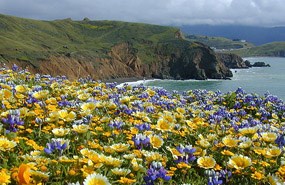
NPS photo Comprised of native bunchgrasses and wildflowers, grasslands once covered large areas of the California coast. As their name implies, bunchgrasses such as purple needle grass, tufted hair grass, blue wild rye, and California oat grass form discrete clumps and are not matt forming. Small plants such as checkerbloom, iris, sanicle, and lomatium filled in the spaces between the grasses along with an abundance of bulbs such as red onion, soap plant, Ithuriel's spear, and brodiaea. Tiny annuals such as goldfields, tidy tips, and clarkia carpet the grasslands each spring. In the summer the grasslands turn from green to golden as species go dormant during California's yearly drought. Native Americans gathered the bulbs and seeds from grasslands for food in the fall harvest, and burned them to create lush green grass to attract prey animals such as deer and elk in the spring. Many of the coastal grasslands around the San Francisco Bay have been lost to development. What remains is impacted by invasive plants and changes in patterns of fire and other disturbance like grazing, among other factors. The intact coastal prairies in Golden Gate National Recreation Area are a rare ecological treasure to be enjoyed and protected. 
NPS photo |
Last updated: February 28, 2015
